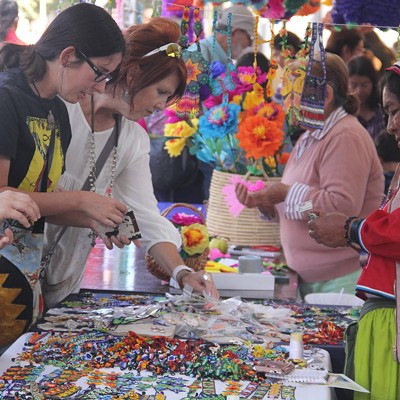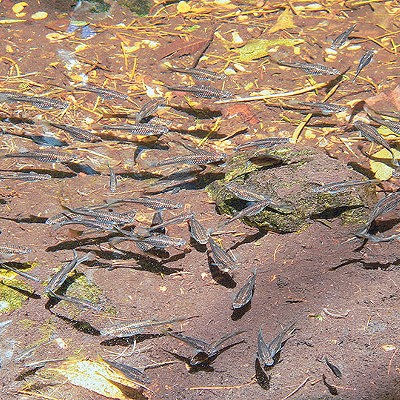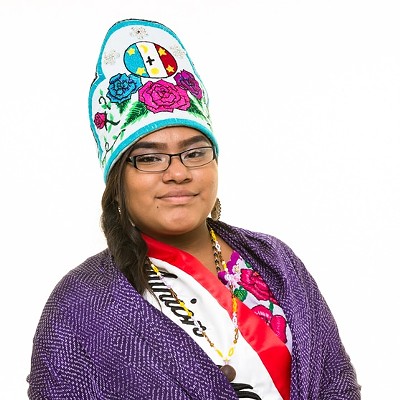Last Christmastime, Jim Griffith glided onto the stage at the end of A Tucson Pastorela, Borderlands Theater's annual holiday retelling of the shepherds' search for Baby Jesus.
That glide was courtesy of the wheelchair he uses, not the wings he wore.
"I wanted to play all seven deadly sins from a wheelchair," the folklorist jokes. Instead, he won a more heavenly role, one easily adaptable to the rolling chair.
"I was a banjo-picking angel," Griffith says. In his celestial moment, he regaled the audience at Leo Rich Theatre with a ballad in praise of Tucson, the city whose traditional arts he's championed for decades.
That same banjo, a five-string model, will make another public appearance this fall, on a stage outside Washington, D.C. Griffith—known everywhere as Big Jim on account of his 6-foot-5 frame—will play at a star-spangled concert at the Music Center at Strathmore in Bethesda, Md., on Friday, Sept. 23. And that's after a banquet and awards ceremony at the Library of Congress.
Big Jim has won a big prize.
In June, Griffith was one of nine Americans nationwide to win a coveted National Heritage Fellowship, the annual National Endowment for the Arts award considered the "nation's highest honor in the folk and traditional arts."
Griffith was singled out for a particular honor. He netted the Bess Lomax Hawes award, given to an individual who has made a "significant contribution to the preservation and awareness of cultural heritage."
The Hawes award, says anthropologist Bunny Fontana, Griffith's friend and longtime neighbor, "is to heritage arts what the Pulitzer is to journalism or the Nobel to economics, literature, chemistry, physics and medicine."
Even Griffith himself, who tends toward self-deprecating humor (he calls himself "lazy from birth and shiftless") concedes the hugeness of the honor.
"I hate to say it," he says. "It's a really big thing."
Each of the winners, who include a Texas quilter and a Mardi Gras "Indian chief," get $25,000 to spend as they please. Griffith says most of his will go right back into Tucson's traditional arts.
"All sorts of beauty is being created in the communities that make up Tucson," he says.
During his long career, Griffith has championed blacksmith work by Mexican-Americans, the jewelbox chapels on the Tohono O'odham Reservation, religious folk painting on both sides of the border, old-time O'odham fiddle music, and dancing by every ethnic group that has ever stepped lively in the Old Pueblo, from the Yaquis to the Irish.
He recalls one particularly revealing moment at Tucson Meet Yourself, the food-and-folk extravaganza he and his wife, Loma, founded back in 1974.
"A Filipino dance group was on stage," he recounts. "Ukrainian kids in costumes were waiting to go on. A Norwegian man in a horned helmet and fur was selling food." Big Jim was reveling in the moment, he says, when "a lady came over and said to me, 'This is just like everything else in Tucson: nothing but Mexicans and Indians.'"
It's been Big Jim's job for years to help Tucsonans see beyond that narrow perspective. He held the post of public folklorist at the UA's Southwest Folklore Center from 1979 to 1998, moving easily between the halls of academe and the streets. He could be seen emceeing, say, an Asian Indian dance concert in a university auditorium or wailing on his banjo in the Posada procession in the old barrio.
A public folklorist, he says, "works outside academe. I'm in the field of education, broad public education."
Everything he's done, he says, from the TV segments he taped for years for KUAT's Arizona Illustrated to the concerts and exhibitions he's staged to the half-dozen books he's published, were aimed at educating a general audience.
Even Tucson Meet Yourself was "conceived and carried out as an educational project. It does have quite a fat sugar coating around it. The only way to educate people is to make the process fun."
Born in Santa Barbara in 1935, Griffith was the child of parents who were "pretty good storytellers, neither of them inhibited by the necessity of sticking to the literal truth. I grew up with oral narratives."
Griffith first arrived in his beloved adopted city as a UA undergrad in 1955, aspiring to study Southwest archaeology.
"After several summers in the field, I discovered cultural anthropology. Those folks studied the same things without the privilege of doing heavy manual labor" in the burning sun. Griffith made the switch from the dig to the dance hall, "drift(ing) from archaeology into cultural anthropology into folklore."
He was always interested in visual art, he says, and the Ph.D. he earned from the UA is in both anthropology and art history. His first fieldwork was a study of the hand-carved masks of northwest Mexico and his dissertation examined the beautiful small chapels sprinkled across the Tohono O'Odham Nation.
An exhibition he curated back in 1996 took up the entire first floor of the University of Arizona Museum of Art. Titled La Cadena Que No Se Corta: The Traditional Arts of Tucson's Mexican American Community, the show was a landmark celebration of working-class arts, of unsung artisans who craft ironwork doors or make quinceañera cakes or paint low-rider cars. One room replicated a classic South Tucson front yard, complete with homemade shrines, potted plants and household saints.
Griffith has covered these arts—an expression of the Baroque in the American Southwest, he calls them—in such books as Southern Arizona Folk Arts and Saints of the Southwest.
For his next book, expected this fall from Tucson's Rio Nuevo Press, he teamed up with Arizona Daily Star cartoonist David Fitzsimmons ("a real smart, talented guy"). Titled A Border Runs Through It: Journeys in Regional History and Folklore, the book has plenty of tales to tell, such as "why Tucson is spelled differently from the way it's pronounced." (Hint: It's not an English name.) Griffith stepped down from Tucson Meet Yourself in 1994, but he stepped back up five years later to help out. He's delighted that it's still going, bigger than ever (100,000 attendees were reported last fall), but has "not sold its soul."
He has nothing but praise for its current managers, including executive director Mia Hansen and board president Maribel Alvarez.
Alvarez, a UA prof, succeeded Griffith as the public folklorist after he retired as the university's public folklorist.
"She's crackerjack," he exults. "Really good. She's a step up from me."
Tucson Meet Yourself is probably Griffith's best-known legacy, but he's proudest of a small-scale initiative back in the 1980s that preserved for posterity the fiddle music of old-time Tohono O'odham musicians.
"The thing I'm most proud of is the fact that with an expenditure of $500 a year we started and ran an O'odham fiddle band contest at the San Xavier powwow."
Fiddles had begun disappearing from traditional O'odham waila bands in the 1950s, he says, displaced by the accordions of the new norteño music coming up from Mexico. The contest gave the old fiddlers a "place to go, play, be heard and have fun."
Even more importantly, it gave them the opportunity to record their music, now all but vanished. Griffith put together 10 CDs of their fiddling.
Griffith has lived for years near Mission San Xavier, a church that's the very definition of the Southwest Baroque. But he now spends summers in a house by the sea, in Santa Barbara, the town where he was born. He and his wife get together with their two grown children ("they have a strange and inexplicable desire not to come to Tucson in the summer") and grandchildren.
Now in his mid-70s, Griffith has had three hip replacements. His health, he says, is "a whole lot better than it was a couple of months ago." And in Santa Barbara he's found a physical therapist who's gotten him out of his scooter and into a walking regimen.
It may just be that when Big Jim arrives on that stage in the nation's capital this fall, to play his banjo and to be honored for a lifetime of work, he'll be walking on his own two feet.














